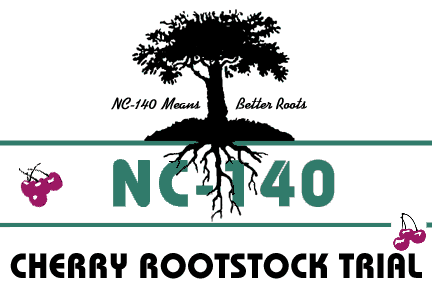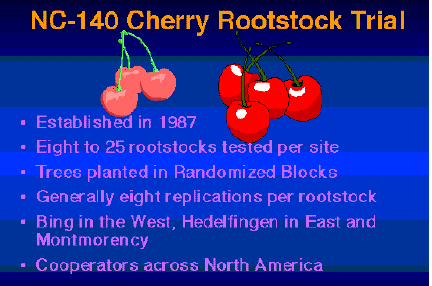
1998 NC-140 Cherry Rootstock
Trial Update, presented by Ron Perry at the 42nd Annual Meeting of the IDFTA,
Hamilton, Ontario CANADA, February 20-24, 1999

| TART CHERRY |
|
SWEET CHERRY |
| Montmorency |
|
Bing |
Hedelfingen |
| Arkansas |
|
BC |
Maryland |
| Kansas |
|
California |
Michigan |
| Michigan |
|
Colorado |
New York |
| New York |
|
Oregon |
Ontario |
| Ohio |
|
Utah |
|
| Oregon |
|
Washington |
|
| Ontario |
|
|
|
| Pennsylvania |
|
|
|
| Utah |
|
|
|
| Wisconsin |
|
|
|

Results/Grower/ Extension Considerations
- Established in 1987
- Eight to 25 rootstocks tested per site
- Trees planted in randomized blocks
- Generally eight replications per rootstock
- 'Bing' in the West, 'Hedelfingen' in East and 'Montmorency'
- Cooperators across North America
|
NC-140 EASTERN* CHERRY/rootstocks
SUGGESTIONS TO DATE
Based on preliminary results (7 seasons)
- Stick with Mahaleb for 'Montmorency' on good cherry soils.
- Change to 'MxM® 2'™ for tarts on poor cherry soils.
- Consider trying Gi 148 family of Gisela® Series for sweets:
- Gisela® 5 = Gi 148-2 about 40-50% of Mazz.
- Gisela® 7 = Gi 148-8 about 30-50% of Mazz. (some suckers & virus
concerns ?)
- Gisela® 6 = Gi 148-1 about 50-70% (?) of Mazz.
- 'MxM® 2'™ for uniform performance and cropping of processing
sweets. Vigor exceeds Mazz.
- Consider trying 'MxM® 60'™ for processing sweets for a slightly
smaller tree than 'MxM® 2'™; good livability.
- INTENSIFY CULTURAL MANAGEMENT: Irrigation, strong annual trimming and
pruning are ABSOLUTELY ESSENTIAL to retain fruit size with Gisela®
Series trees.
- Remember that only 'Hedelfingen' trials are mature to date, so other
varieties may give different results for you.
*The suggestions listed here are the results
of NC-140 cherry trials planted in 1987 that tried 19 stocks. Tests were conducted
in Eastern cherry states: Michigan, New York, Pennsylvania, Wisconsin; and Arkansas,
Maryland, Ohio and Kansas, as well as the province of Ontario. Our suggestions
should be treated as preliminary results.
NC-140 WESTERN* SWEET
CHERRY/rootstocks KEY OBSERVATIONS & SUGGESTIONS
Based on preliminary results (7 seasons)
- 'Bing' has been precocious (3rd leaf fruiting) and is very productive
on the following Gisela® rootstocks:
- Gisela 5® = Gi 148-2 about 50-55% of Mazz.
- Gisela 12® = Gi 195-2 about 70-75% of Mazz.
- Gisela 6® = Gi 148-1 about 90-95% of Mazz.
- Virus tolerance in the 3 rootstocks above appears to be as good as Mazzard,
Mahaleb and 'Colt'; some others that showed adverse sensitivity were culled.
- Successful intensive culture of trees on precocious, productive rootstocks
requires very careful attention to pruning, irrigation and nutrition. The
most dwarfing combinations need more vigor stimulation to promote shoot
growth and fruit size.
- Dwarf cherry orchards deserve better sites for frost protection because
flowers are concentrated close to the ground.
- Processing cherry rootstock decisions probably require more emphasis on
yield than fruit size or tree vigor.
- Consider trying 'MxM® 60'™ for processing sweets for a more productive
tree than 'F12/1'; better drought tolerance and bacterial canker tolerance
equal to 'F12/1'.
- Remember that only 'Bing' trials are mature to date, so other varieties
may give different results for you.
- Both 'MxM®39' and 'Gisela® 12' were equal to Mahaleb in Oregon
for Montmorency with 'Gisela® 12' preferred for droughty sites and 'MxM®39'
for wet soils.
* The suggestions listed here are the preliminary
results of NC-140 cherry trials planted in 1987 to evaluate 19 stocks in British
Columbia, California, Colorado, Oregon , Utah and Washington. 








